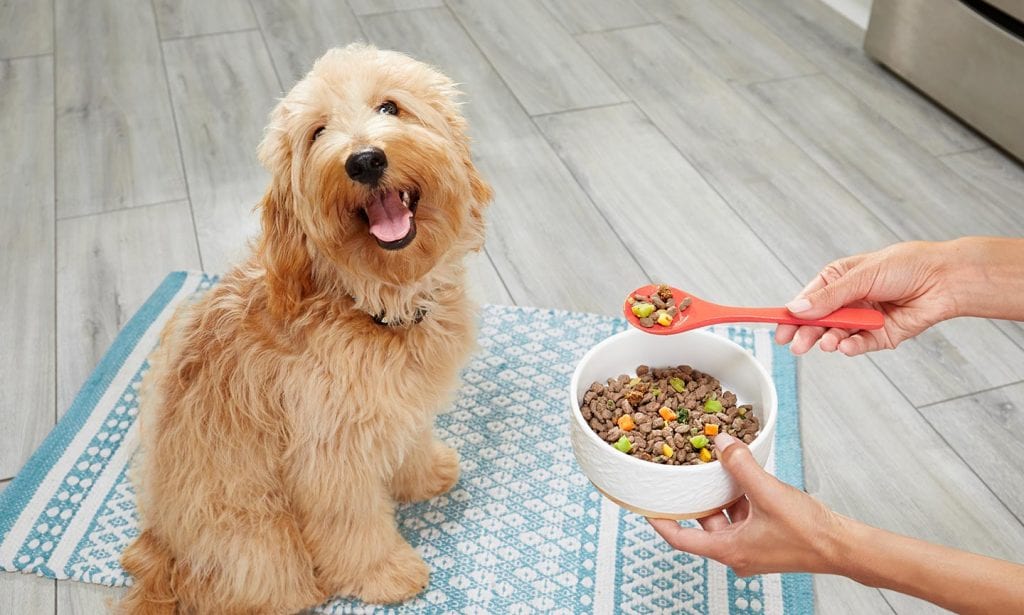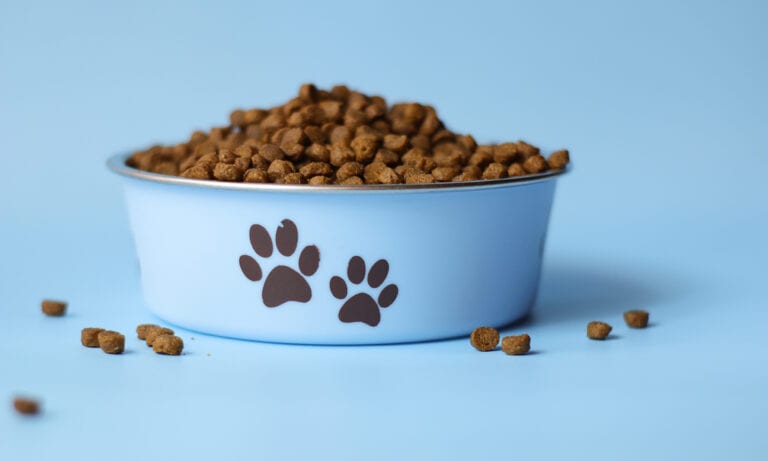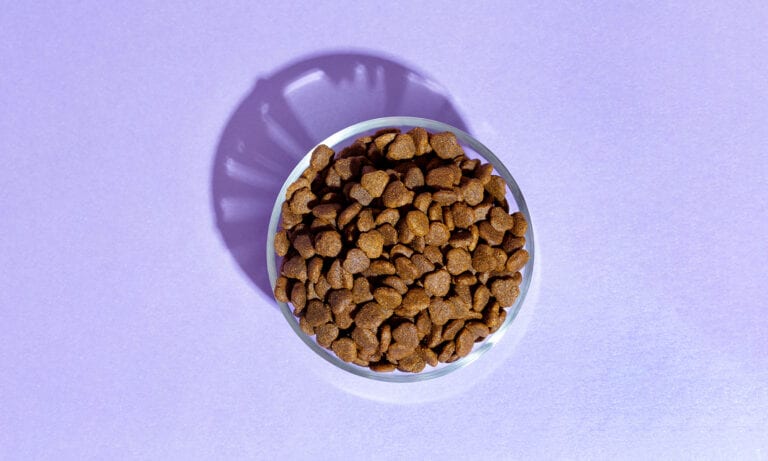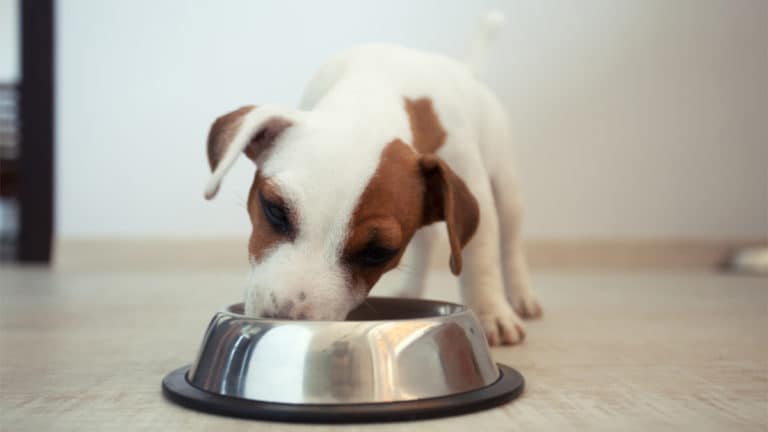When it comes to the healthiest and most fulfilling food for you to eat, fresh is almost always best. But is the same true for your dog? Fresh dog food is gaining in popularity, with sales of brands like Freshpet and JustFoodForDogs growing at the fastest rate of any type of dog food, thanks to pet parents who say its benefits, from health perks to convenient delivery, can’t be beat. So how do you know if fresh dog food is a good choice for your pup?
To find out, we talked to several vet experts about the benefits of fresh dog food, the best fresh foods for dogs and more—to help you make the right call for your furry friend.
Click to jump to each section:
What Is Fresh Dog Food?
“Fresh”—it sounds great, but what does it actually mean? There’s no legal definition of “fresh” when it comes to dog food, but our experts say there are four common attributes most fresh foods share:
- Fewer preservatives and additives. Most fresh dog food brands say their products have fewer ingredients that prolong shelf life, like preservatives and other additives.
- Must be refrigerated or frozen. Because fresh foods have fewer preservatives, they must be stored in the refrigerator or freezer—they’re not shelf-stable.
- Minimal processing. It’s common for other types of dog food to be processed to change its shape or texture—that’s how ingredients like chicken or sweet potato become pellets of dry kibble, for example. Fresh dog food, on the other hand, uses less processing, so you can often recognize the ingredients it includes, such as carrots or peas, just by looking at it.
- Familiar ingredients. While the specific recipes will vary from one food to the next, fresh foods for dogs are typically made of ingredients you might find on your own dinner plate. Think of proteins like turkey or beef, and fruits and veggies like spinach and blueberries. Fresh foods usually contain at least one source of protein, along with fruits, vegetables and sometimes a source of carbohydrate, like rice or potatoes.
What Are the Benefits of Fresh Dog Food?
Fewer preservatives
Fans of fresh foods for dogs say that the diets’ fewer preservatives is one of their biggest selling points. Here’s the basic idea: Preservatives are essentially chemicals designed to extend a food’s shelf life. When a dog’s diet has more chemicals, their body needs to do more work to detoxify, aka remove them from the body. That process can lead to inflammation—“and inflammation is the root cause of many diseases,” explains Dr. Shawn Messonnier, DVM, of Paws & Claws Animal Hospital and Holistic Pet Center in Plano, Texas.
Supports skin and coat health
Some fresh dog foods are high in omega-3 and omega-6 fatty acids, which are known to reduce inflammation and promote hair growth.
Increased digestibility
Digestibility is a measure of how much of the nutritional value of a food is actually absorbed during the digestion process—and the more digestible, the better! Studies have shown that fresh dog food is more highly digestible compared to dry kibble and other more processed diets.
High-quality ingredients
You’ll need to check your dog food’s label to know for sure, but many fresh dog foods are made from specially selected ingredients. The fruit and vegetables in Freshpet dog food, for example, are verified non-GMO, meaning they haven’t been altered by genetic engineering.
Visual appeal
Let’s face it: Most dog food just doesn’t look that appetizing. Fresh food, on the other hand, can actually be enjoyable for you to serve to your pet. Because it’s less processed, fresh diets look more like natural food—a difference both you and your pet can appreciate.
Convenient delivery
Many brands of fresh food can be delivered right to your door, saving you a trip to the store. When you buy fresh dog food from Chewy, for instance, it’s delivered to your doorstep in temperature-controlled packaging that’s designed to keep your pet’s food fresh.
Formulated to meet dogs' needs
The best fresh foods for dogs are formulated to meet Association of American Feed Control Official (AAFCO) guidelines for dog food, ensuring they provide all the nutrients your dog needs to thrive. Look at your pet’s food label for a nutritional adequacy statement that says it meets AAFCO standards.
There’s one more important thing to consider when it comes to fresh dog food: Studies have not conclusively shown that fresh diets are better for all dogs.
"There are no actual documented scientific benefits of fresh versus not fresh," says Dr. Lindsey E. Bullen, DVM, DACVN, Board Certified Veterinary Nutritionist of BluePearl Veterinary Specialty Hospitals in Cary, Raleigh and Durham, North Carolina. "Every pet is unique, just as every human is unique. We all need the same nutrients, but the concentrations, quantities and proportions are all going to be a little different."
That means fresh food isn’t the best choice for every single dog—but it might be a great choice for your dog.
How Is Fresh Food Different From Other Dog Foods?
Health Benefits
The health benefits of fresh dog food compared to other diets will depend on the specific needs of your unique pup. Yes, many pet parents prefer fresh dog food because of its fewer preservatives and high-quality ingredients. But other types of foods may have different benefits for certain dogs, such as prescription diets. The best way to determine which food is healthiest for your dog is to talk to your vet.
Ease of Use
Depending on the type of fresh dog food you choose, preparing your dog’s fresh meal may take a bit longer than it takes to open a can or drop a scoop of kibble into a bowl. Fresh food that comes in a roll, for example, typically needs to be cut up into bite-size chunks for your dog before serving. Other fresh foods avoid that pitfall, like FreshPet’s Vital diets that come in a bag, rather than a roll, so you can scoop them out just like dry foods. If you choose to keep your fresh dog food in the freezer, which many brands recommend to keep it fresh for longer, you'll need to remember to thaw it in your refrigerator before serving it to your dog, too.
Storage
Do you have space in your refrigerator or freezer to keep your dog’s food? When you’re considering switching to fresh dog food, that’s a very important question. Shelf-stable foods can be stored anywhere. (Well, anywhere your hungry dog can’t reach them.) But because fresh foods are designed to be served, well, fresh, they need to be kept cool, either in your fridge or freezer. Many types of fresh pet food don’t take up excessive shelf space, and home delivery can make it easy to stay stocked up without running to the store. But this does mean it could be difficult to buy your pet’s food in bulk—unless you plan to invest in a mini-fridge for your pup. (Hey, it’s an option!)
Price
Fresh food is sometimes slightly more expensive than dry or canned food, Dr. Messonnier says, so if you plan to switch from kibble, you may need to factor a little extra money into your pet food budget. Remember, however, that the health benefits of fresh food could translate into lower overall health costs for some dogs.
Pet Preferences
Don't forget to consider your dog’s tastebuds! Some dogs simply like the taste of fresh food more than kibble or canned food. If you have a picky eater or a pup who’s underweight, fresh food may inspire them to add more calories to their diet. On the other hand, if your dog is already a voracious eater, you’ll want to be careful to feed them proper portion sizes to avoid obesity and the health issues that accompany it, like heart disease and diabetes.
Is Fresh Food Right for My Dog?
While fresh foods for dogs may be the way to go for some pups, there are cases when fresh isn’t the right call, including:
- If your dog has a medical issue, they may need a prescription diet that’s unavailable in fresh form.
- If your dog is allergic to an ingredient in fresh food, that reaction is likely to outweigh the benefits of fresh food.
Pet parents should also consider their own lifestyle factors:
- Can you afford to buy fresh food?
- Are you able to store the food at a frozen or refrigerated temperature to ensure it doesn’t spoil?
How to Incorporate Fresh Dog Food Into Your Dog’s Diet
1. As mixer add-ons or toppers to their current food
Mixing and topping fresh dog food to kibble is not only a more cost-effective way to introduce fresh food into your dog's diet, but it can also add more nutrition—and excitement.
“Fresh dog food is generally more palatable than processed canned or dry, so it will frequently get the dog more interested in their meal,” Dr. Richter says.
And for dogs who could use more omegas or probiotics in their diet, fresh dog food could be used as a dietary supplement. Because every dog has their own unique nutritional needs depending on factors—including age, breed, health status and activity levels—fresh dog food options makes it easier to adequately provide your furry pal with extra nutrients they may need.
When selecting mixer and topper options for your dog, consider their specific dietary requirements and any potential sensitivities or allergies they may have, Dr. Schechter says. It’s always a good idea to consult with your veterinarian.
Vet-recommended mixers and toppers:
2. Exclusively as their meal
Fresh dog food brands, like JustFoodForDogs, Freshpet and Instinct, provide customized meal plans so you can find the best possible match for your dog. These options are especially helpful if you’re looking to feed a special diet, like a human-grade, grain-free or high-protein diet, without all the guesswork.
According to Dr. Richter, fresh dog food is more nutritionally beneficial than canned or kibble. He compares it to being the same as a person eating a fresh, whole food diet, rather than all processed food. Fresh food, he says, supports good body function, gut health, lower inflammation and generally promotes health and longevity.
You can purchase fresh dog food in-store or online. One benefit to opting for the latter is you can get it delivered right to your doorstep.
How to Switch to Fresh Dog Food

Consulting your vet or a veterinary nutritionist is the best way to get the transition just right for your pet.
Your vet can also weigh in on portion control. While most fresh pet foods come with detailed feeding instructions to help you determine how much to feed your dog, some pets may need more or less than what the manufacturer suggests.
However you make a switch to your pet’s diet, make sure you do it gradually. “The last thing we want is for a pet to have diarrhea or vomit or not feel well,” Dr. Bullen says. She recommends gradually introducing the food for between five to seven days for typical, healthy dogs, and up to 14 days for dogs with sensitive stomachs. Mix increasing amounts of the food into your dog’s current diet over the course of the transition.
How to Prepare Fresh Dog Food
- Fresh dog food in a roll: Some fresh foods for dogs, such as certain varieties of Freshpet, come packaged in a roll or tube. To serve it to your dog, cut off a slice, making sure it’s the correct portion size. Many rolls will have measurements printed on the packaging to help you know where to slice. Then, cut that slice into small pieces that your dog can easily chew and swallow. Store the remainder in the refrigerator until your pup’s next meal.
- Fresh dog food in a bag: Other fresh foods for dogs come pre-cooked in a bag, ready to open and eat. For example, Freshpet’s bagged recipes are gently steamed at low temperatures, then vacuum sealed and ready for the fridge. To serve, scoop the correct portion size out of the bag and drop it into your pet’s bowl—it’s that easy.
If you've been keeping your dog food in the freezer, remember to thaw it in your refrigerator before serving it to your dog.
For any fresh dog food—or any food at all, for that matter—always read the manufacturer’s guidelines for serving. Remember: It’s best to work with your vet to ensure you’re using the correct preparation and feeding strategies.
Fresh Dog Food FAQs
Q:
Is fresh dog food healthier for dogs?
Q:
Can puppies eat fresh dog food?
Q:
What is the best fresh dog food?
Q:
Can I make fresh food for my dog?
More on dog food:
Share:














